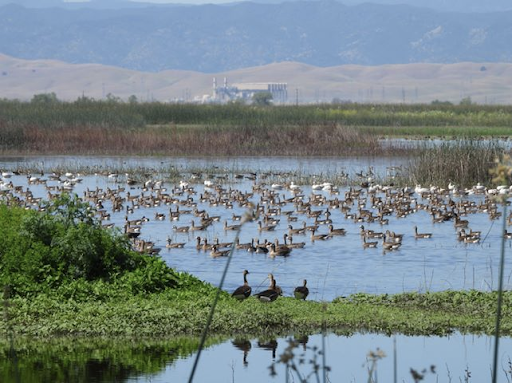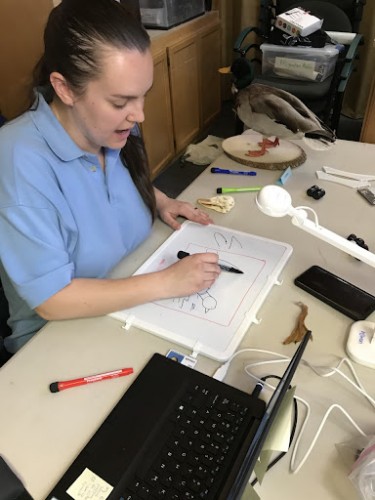Engaging College Opportunity Programs, Researchers and Students through Citizen Science: Reimagining Possibilities of STEM and CTE
In January of 2020, the UC Davis Center for Community and Citizen Science (CCCS) began a new research practice partnership exploring STEM opportunities and developing teacher professional development with the college opportunity program GEAR UP (Gaining Early Awareness and Readiness for Undergraduate Programs), serving students across Glenn, Colusa, and Tehama counties. Together with the GEAR UP team, CCCS aimed to explore ways that professional development for educators and summer programming for students around citizen science could improve STEM learning. The team also focused on exposure to and engagement with a variety of career and technical education paths with the aim of improving college readiness. And then, Covid 19 hit.
 As teachers and students began a school year in
distance and then later hybrid learning, many struggled with ways
to develop classroom culture that engaged and inspired students
as they developed an emotional connection, all while attending to
both their academic needs as well as social and emotional needs.
With limited time in person (or virtually), many teachers were
also looking for ways to connect with students and make space for
students to collaborate with one another. One possible
answer: engage students of all ages in authentic, real world
participatory science connected to place.
As teachers and students began a school year in
distance and then later hybrid learning, many struggled with ways
to develop classroom culture that engaged and inspired students
as they developed an emotional connection, all while attending to
both their academic needs as well as social and emotional needs.
With limited time in person (or virtually), many teachers were
also looking for ways to connect with students and make space for
students to collaborate with one another. One possible
answer: engage students of all ages in authentic, real world
participatory science connected to place.
Youth-focused community and citizen science (YCCS) involves young people directly in the scientific production of knowledge. In YCCS, young people contribute to professional research, influence management and policy, and impact environmental conservation in their communities. Youth-focused community and citizen science engages students in real-world authentic investigations while deepening their content knowledge and skills as well as increasing their capacity to tackle environmental and community problems. In addition to engagement with content standards, YCCS projects can also be used to make space for attending to the Social and Emotional Learning (SEL) of students. As the project team began to look at ways to shift support of educators and students, it was the authentic nature of community and citizen science, as well as the utilization of an already digital project, Cornell’s eBird Monitoring Project, that allowed for the partnership to develop student engagement during the pandemic.
GEAR UP utilizes a cohort approach, over time becoming a systemic vehicle for change and innovation through partnerships with schools to support ongoing efforts toward college and career readiness and postsecondary enrollment. The GEAR UP goals are delivered with a focus on STEM education, public speaking and creating internship opportunities. With the closing of school sites, and limited contact between students and advisors the Center for Community and Citizen Science began by developing student resources and professional learning for educators that focus on GEAR UP goals with a STEM-CTE focus that would also support the social and emotional learning needs of students during distance/hybrid learning.
Peggy Harte, Youth Education Program Manager at CCCS reached out to the education team at the Sacramento National Wildlife Refuge (formerly a site for GEAR UP field trips) with the idea of engaging students in bird monitoring while virtual, and making connections to the birding hotspot that is the refuge. Amanda Geahry and Lora Haller from the Sacramento National Wildlife Refuge were excited by the opportunity to engage youth in authentic learning, both around the refuge itself, as well as supporting the monitoring project students would be participating in. Together with Stacey Garrett, Project Director and Cody Lane, Evaluation Director for GEAR UP, the team began to map out a hybrid program to engage students both in and out of the classroom.
Authentic Engagement: With and By Students
The concept of virtual field trips was not new to the pandemic. Many non-formal education programs had already made the shift by utilizing platforms like FlipGrid or Youtube to engage youth in place based learning. What was different about this partnership from the outset was that it would be designed to:
- Train teachers and advisors in the pedagogical practices of YCCS engagement (see framework)
- Develop lessons that engage youth in authentic scientific inquiry, monitoring birds near their homes and school campus (when in-person or hybrid) by participating in a global bird monitoring project, eBird.
- Through the virtual engagements, build in and highlight connections between content students were learning in class and STEM fields/career paths at refuge.
- Expose students to a variety of CTE Environmental Resource Pathways by emphasizing “real-world, occupationally relevant knowledge, skills and experiences.”
Teachers were offered professional development in advance of the engagement with the refuge. Lessons were shared that could be taught in class before each virtual engagement with the members of the SNWR team, focusing on the history and engineering of the refuge, ways that biodiversity is monitored and supported, and the wide variety of STEM fields that were represented. This unit of study offered 5 lessons that could be taught synchronous or asynchronous, with 4 opportunities to engage with the staff at the refuge itself.
What went well with classrooms:
- The lessons and engagement were interactive, in spite of the pandemic.
- Lessons met the goals of introducing STEM fields and CTE skills connected to content.
- Authentic interaction with environmental scientists from the SNWR virtually when students were online (being able to see faces/reactions).
- Teacher feedback was positive, and reported students were very interested in content.
- Virtual engagement allowed for students who would not normally visit due to accessibility and cost.
- Met many GEAR UP goals, focusing on potential career pathways.
In addition to the positive engagement between classrooms and the refuge, we also found there were many positive outcomes for the collaboration between the three partners — the Sacramento National Wildlife Refuge, the GEAR UP STEM RVP and the Center for Community and Citizen Science.
Benefits of Collaboration:
- Reaching out to schools, engaging with students who may not have had access
- Attending to equity during distance/hybrid learning by ensuring engagement platforms and materials across teams were supportive of student needs
- Variety of skill sets within team allowed for the ability to make necessary shifts to support both teachers and students during the pandemic
- Getting kids excited about something outside of school, focusing on regional opportunities for both STEM fields as well as personal exploration
- Opportunity to build relationships between environmental biologists and the US Fish and Wildlife, UC Davis, GEAR UP, and students directly.
While there were many kinks to work out along the way, the 2020/2021 program allowed for authentic student engagement with science concepts through participating in the eBird monitoring project, exposure to a variety of STEM fields represented by local members of the refuge, all while expanding student understanding of what it means to be a scientist.









